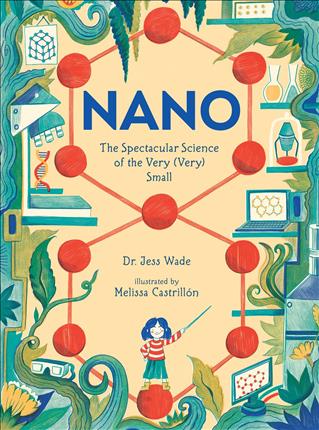| Nano : the spectacular science of the very (very) small Author: Wade, Jess | ||
| Price: $6.50 | ||
Summary:
An acclaimed physicist and debut picture-book author introduces readers to the tiny building blocks that make up the world around us. Friendly text and stylish illustrations explain atoms, the elements, and other essential science concepts and reveal how very (very) small materials are manipulated to create self-washing windows; stronger, lighter airplanes; and other wonders of nanotechnology.
| Illustrator: | Castrillon, Melissa |
| Accelerated Reader Information: Interest Level: LG Reading Level: 5.70 Points: .5 Quiz: 515485 |
Reviews:
Kirkus Reviews (+) (09/01/21)
School Library Journal (+) (00/09/21)
Booklist (09/15/21)
Full Text Reviews:
School Library Journal - 09/01/2021 Gr 1–4—Using clear, down-to-earth language, a friendly writing style, and a touch of humor, this book explains the nature of nanoscience—the study of very, very small materials. The explanations are perfect for young readers. They begin with what children know ("Look around your home. Everything is made out of something") and then proceed to introduce words readers need to know such as atom, molecule, graphite, grapheme, and nanomaterial. The author doesn't hesitate to speak directly to the reader. After explaining that everything on Earth is made from atoms, she writes, "Stop: read that last sentence again. It's a gigantic idea to get your head around, but it's too important to skip over." The written content is presented using engaging and effective examples that are well-supported by the illustrations. A discussion of how nanoscience is a work in progress discusses how graphene, a material made from a single layer of graphite, is already being used to make lighter airplanes that require less fuel and emit less pollution and windowpanes that wash themselves using only sunlight. The illustrations show "Before" and "After" pictures of both planes and windows. Throughout the book, readers are also told about the nature of science—how discoveries are often preceded by years of failure, that exciting discoveries are yet to come, and that these discoveries might even be made by the reader. VERDICT An excellent book for getting young children interested in science, this supports classroom studies of matter, the work of scientists, and the possibilities of future discoveries.—Myra Zarnowski, City Univ. of New York - Copyright 2021 Publishers Weekly, Library Journal and/or School Library Journal used with permission.
Booklist - 09/15/2021 It’s incredible to think that everything in the world is made up of smaller parts. In some cases, it’s easy to see: a book has pages of paper, and a bedspread is made of cotton, but what makes up the things that make up other things? Everything in the physical world is made up of atoms. It’s a huge (tiny) topic to tackle, but Wade, a physicist, breaks the topic down into delightful morsels, introducing young readers to the wonders of nanoscience. The book follows a spritely, blue-haired girl around her colorful world as basic concepts of physical matter are established: atoms, molecules, elements. Once those ideas are in play, Wade delves even further into the scientific possibilities surrounding the use of nanomaterials, from new environmental technologies to medical breakthroughs. Castrillón’s intricate illustrations are vibrant and inviting, equally adept at capturing whimsical landscapes and detailed scientific explanations. An appealing and enlightening introduction to the small parts of a big universe. - Copyright 2021 Booklist.



